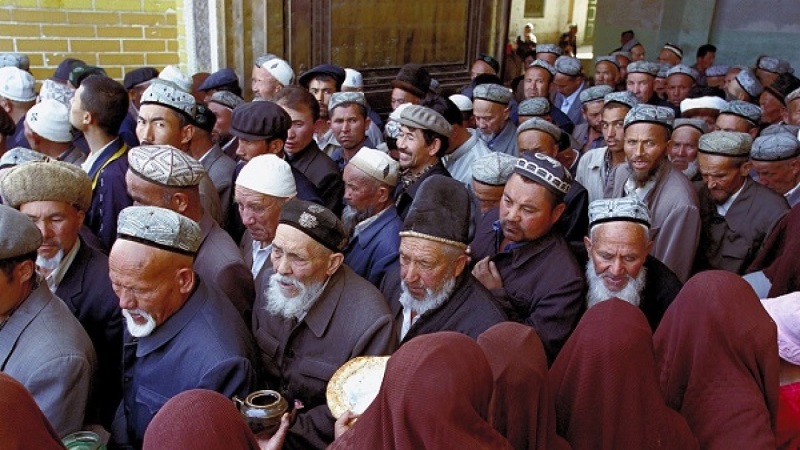Several years back, a former worker at the Parkdale Textile Mills (largest consumer of cotton in U.S.) knocked on my door in south Charlotte asking to trim trees for $50. After 17 years as a machine mechanic there, he explained, the company had asked him to move to Mexico where they were building a plant. Refusing to go, they asked him to teach visiting Mexicans to fix the machines. He refused and quit. The day he visited me two years later, he was desperate to make some money.
It doesn’t take a lot of searching to see the hundreds of textile mills closed across North and South Carolina’s Piedmont region. Most stand like dead dinosaur skeletons testifying to the move of production of textiles out of America and mainly to China and Mexico—the first because of insufficient TARIFFS and the second because of NAFTA.

Wages for most Americans are falling while we prop up the Chinese economy by purchasing slave labor made goods. Photo shows Uyghur forced labor shop in China. Photo: Radio Free Asia.
Tariffs are tax duties on foreign goods designed to protect American businesses and workers from unfair competition from abroad. U.S. Census and Economic Bureaus show that since 1977, America’s “Trade Balance” has totally shifted. This occurred near the time when the U.S. government lowered overseas TARIFFS to allow small foreign cars in to promote burning less gasoline here.
Through the 1950’s, 60’s and 70’s, the U.S. exported many more manufactured products overseas than we imported. In 1977, it began a negative shift that now reaches over HALF A TRILLION DOLLARS each year MORE spent for imported goods than we export (see chart). In addition to this major change, NAFTA agreements allowed more goods to easily flow from Mexico, encouraging factory owners to relocate in the 1990’s over the border where workers’ would work for cheaper wages. Our manufacturing heydays are over!
U.S BALANCE OF TRADE (Imports Versus Exports)
IMPORTS EXPORTS DIFFERENCE
1960 $ 22.4 billion $ 25.9 billion $ 3.5 billion
1964 $ 27.3 $ 33.3 $ 6.0
1977 $ 179.5 $ 152.3 — $ 27.2
1987 $ 500.5 $ 348.9 – $ 151.7
1997 $ 1.04 TRILLION $ 934 billion – $ 108 billion
2007 $ 2.35 TRILLION $ 1.65 TRILLION – $ 697 billion
2020 $ 2.55 $ 1.94 – $ 605 billion
If you look around the U.S., especially in the cities, you will see plenty of nice homes, even communities seemingly thriving. In some areas, construction is doing well. You may wonder if it really matters if we import so much or our factories move over the border? Aren’t we helping poor Chinese workers have better lives? And we enjoy cheaper goods we believe because they are imported.

Xinjiang, China, re-education camp. Photo Wikipedia
REALITY CHECK: Not only are TENT CITIES on the rise in America, but our MINIMUM WAGE HAS REMAINED AT $7.25 per hour for 12 years! From 1967 when minimum wage was $1.00 per hour, that rate steadily increased until 2009—WHEN THE MINIMUM WAGE STOPPED GROWING. By that time, most factories and manufacturing production had become a thing of the past in America! While 75% of South Carolina’s manufacturing work force was employed in 190 mills in the 1930’s, after World War II, this jumped to 445 mills but dropped back to only 300 by 2002. Now roughly 250,000 state employees work in manufacturing—only 11.5% of the population.
MINIMUM WAGE
1967 $1.00 hr
1976 2.30 hr
1990 3.80 hr
2007 5.85 hr
2009 7.25 hr
2014 7.25 hr
2021 7.25 hr
(US Dept of Labor statistics)
Our workers who must continue in the lowest wage jobs can no longer feel guaranteed they might at least work in a factory. In addition to essentially competing against low-wage workers in other countries for jobs, workers here in sites like factories have also felt the pinch of being replaced by a much more mechanized production operation—man versus machines with man losing. While Parkdale Mills still boasts factories across the Southern U.S., Mexico and Central America, their total number of employees is only 3,000.

Inman Mill in Spartanburg County, South Carolina, used to employ hundreds. That was before NAFTA and the Chinese textile invasion closed it in 2001.
Low-end jobs are scarce these days. Most are part-time in retail or fast food sectors and retail is under “attack” by Amazon home delivery. Some employers have voluntarily increased their wages—but not all. With more and more illegal (and legal) immigrants coming in—many of whom must seek low-end jobs, the bargaining power of those on the bottom of our society is dwindling ever more each day in South Carolina and elsewhere. With fewer jobs to choose from, how can they expect to get higher wages or better benefits?
You may think that only the poorest workers are affected by the change in America’s economy; hardly so. As more money flows to other countries like China and Mexico, their economies grow richer. As their workers’ wages increase, so do their standards of living. What does this have to do with us? As the standard of living in these countries rise, their people can pay more for their goods and THEIR costs for consumers will rise. This means that as their standards of living increase, these countries will actually charge us more for the goods we import from them. Meanwhile, with our factories closed and fewer jobs in the U.S., we will have nowhere to turn to purchase Made in the USA goods! This is the basic “Law of Supply and Demand.”
CHILD LABOR AND SLAVERY
UNICEF, the United Nations Children’s Fund, states that one of four children in the poorest countries is involved in child labor, according to their report October 2019. While some of the worst are in areas of Africa, even regions like Mongolia, Afghanistan and Nepal show numbers around 1 of 4 or 5 children, and southeast Asian countries are not far behind.
It is reported that children in countries such as Cambodia and parts of Africa are routinely sold into slavery—even today and at times by their own desperate parents. It is also certain that the cheap goods imported into America are cheap at times because of these America abhors: SLAVERY AND CHILD LABOR.

Over 80,000 Uighur Muslims were forced to work in factories owned by international companies in China.
In China, statistics on child labor are not shared with UNICEF, but recent reports have shed light on LABOR CAMPS known to be located in its westernmost region called Xinjiang, documented by German anthropologist Adrian Zenz and reported by the New York Times and U.S. government officials.
The Chinese people are primarily Muslim and a campaign of forced coercion to China’s Communist Party principles has been on-going there. With estimates exceeding one million Uygher detainees in camps,.in September 2020, it was reported that China has built 380 new internment camps (Emma Graham-Harrison, The Guardian website). These camps have been seen in satellite images by Australian Strategic Policy Institute. Further evidence has come from survivors who fled abroad and by leaked government documents. Reports have included scenes of torture and killings. U.S Secretary of State nominee Blinken stated that he will make Xinjiang forced labor camps a priority (Reuters, Jan. 19).
Photographs show the camps to be surrounded with high storm fencing and having elevated guard towers. More photographs from inside the camps have shown the Uygher people detained there producing garments for sale abroad. It is reported that almost half of Xinjiang’s exports are apparel and textiles, and about 85% of China’s cotton production is in Xingiang province.
T-shirts from the internment camps were tracked recently to a large school system purchase in Statesville NC (near Charlotte) as well as to a large, private school in Charlotte itself (Charlotte Observer). Despite claims by the Chinese government that their “RE-EDUCATION PROGRAM” in these camps has been “winding down,” new camps have been built with even higher security (The Guardian).
While the Southern people fought an awful war and have been berated for a century and a half over slavery that originally helped provide cheaper goods to Great Britain–where slavery was banned–are Americans to now turn our backs and a blind-eye to the evil practices of slavery and child labor which are certain to help produce cheap goods for us here today?
Lisa C. Rudisill is a magna cum laud graduate of NC State University and a Master of Theology from Liberty University. She writes novels about her family history during the Civil War in North and South Carolina. She is a freelance writer, editorialist and a contributor to The Standard newspaper.
Please “like”, comment, share with a friend, and donate to support The Standard on this page.



 RSS - Posts
RSS - Posts